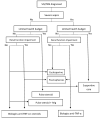A Review of the Systemic Treatment of Stevens-Johnson Syndrome and Toxic Epidermal Necrolysis
- PMID: 36140207
- PMCID: PMC9495335
- DOI: 10.3390/biomedicines10092105
A Review of the Systemic Treatment of Stevens-Johnson Syndrome and Toxic Epidermal Necrolysis
Abstract
Stevens-Johnson syndrome (SJS) and toxic epidermal necrolysis (TEN) are uncommon but life-threatening diseases mostly caused by drugs. Although various systemic immunomodulating agents have been used, their therapeutic efficacy has been inconsistent. This study aimed to provide an evidence-based review of systemic immunomodulating treatments for SJS/TEN. We reviewed 13 systematic review and meta-analysis articles published in the last 10 years. The use of systemic corticosteroids and IVIg is still controversial. An increasing number of studies have suggested the effectiveness of cyclosporine and biologic anti-TNF-α in recent years. There were also some promising results of combination treatments. Further large-scale randomized controlled trials are required to provide more definitive evidence of the effectiveness of these treatments. The pathogenesis of SJS/TEN has been elucidated in recent years and advances in the understanding of SJS/TEN may inspire the discovery of potential therapeutic targets.
Keywords: Stevens–Johnson syndrome; meta-analysis; toxic epidermal necrolysis.
Conflict of interest statement
The authors declare no conflict of interest.
Figures
Similar articles
-
Stevens-Johnson Syndrome and Toxic Epidermal Necrolysis: A Concise Review with a Comprehensive Summary of Therapeutic Interventions Emphasizing Supportive Measures.Adv Ther. 2017 Jun;34(6):1235-1244. doi: 10.1007/s12325-017-0530-y. Epub 2017 Apr 24. Adv Ther. 2017. PMID: 28439852 Free PMC article. Review.
-
Current Perspectives on Stevens-Johnson Syndrome and Toxic Epidermal Necrolysis.Clin Rev Allergy Immunol. 2018 Feb;54(1):147-176. doi: 10.1007/s12016-017-8654-z. Clin Rev Allergy Immunol. 2018. PMID: 29188475 Review.
-
Recent advances in managing and understanding Stevens-Johnson syndrome and toxic epidermal necrolysis.F1000Res. 2020 Jun 16;9:F1000 Faculty Rev-612. doi: 10.12688/f1000research.24748.1. eCollection 2020. F1000Res. 2020. PMID: 32595945 Free PMC article. Review.
-
Positive experience with TNF-α inhibitor in toxic epidermal necrolysis resistant to high-dose systemic corticosteroids.Front Med (Lausanne). 2023 Jul 24;10:1210026. doi: 10.3389/fmed.2023.1210026. eCollection 2023. Front Med (Lausanne). 2023. PMID: 37554504 Free PMC article.
-
Biologic TNF-alpha inhibitors in the treatment of Stevens-Johnson syndrome and toxic epidermal necrolysis: a systemic review.J Dermatolog Treat. 2020 Feb;31(1):66-73. doi: 10.1080/09546634.2019.1577548. Epub 2019 Feb 19. J Dermatolog Treat. 2020. PMID: 30702955
Cited by
-
Case report: Toxic epidermal necrolysis as a unique presentation of acute graft versus host disease in a pediatric patient.Front Immunol. 2025 Jan 23;15:1452245. doi: 10.3389/fimmu.2024.1452245. eCollection 2024. Front Immunol. 2025. PMID: 39916964 Free PMC article.
-
Survival Following Steroid-Based Therapy in a Case of Penicillin-Induced Stevens-Johnson Syndrome and Toxic Epidermal Necrolysis Overlap.Cureus. 2025 Jun 5;17(6):e85396. doi: 10.7759/cureus.85396. eCollection 2025 Jun. Cureus. 2025. PMID: 40621364 Free PMC article.
-
Allopurinol: Clinical Considerations in the Development and Treatment of Stevens-Johnson Syndrome, Toxic Epidermal Necrolysis, and Other Associated Drug Reactions.Cureus. 2024 Jul 16;16(7):e64654. doi: 10.7759/cureus.64654. eCollection 2024 Jul. Cureus. 2024. PMID: 39149682 Free PMC article. Review.
-
Nevirapine-Induced Stevens-Johnson Syndrome in an HIV-Infected Patient: A Case Report From Uganda.Int Med Case Rep J. 2025 Feb 13;18:249-253. doi: 10.2147/IMCRJ.S508884. eCollection 2025. Int Med Case Rep J. 2025. PMID: 39963116 Free PMC article.
-
Molecular Docking Analysis of Four Drugs (Phenytoin, Amoxicillin, Aceclofenac and Ciprofloxacin) and Their Association With Four Human Leukocyte Antigen (HLA) Alleles.Cureus. 2024 Jun 12;16(6):e62269. doi: 10.7759/cureus.62269. eCollection 2024 Jun. Cureus. 2024. PMID: 39006565 Free PMC article.
References
-
- Yang M.S., Lee J.Y., Kim J., Kim G.W., Kim B.K., Kim J.Y., Park H.W., Cho S.H., Min K.U., Kang H.R. Incidence of Stevens-Johnson Syndrome and Toxic Epi-dermal Necrolysis: A nationwide population-based study using National Health In-surance Database in Korea. PLoS ONE. 2016;11:e0165933. doi: 10.1371/journal.pone.0165933. - DOI - PMC - PubMed
-
- Hoffman M., Chansky P.B., Bashyam A.R., Boettler M.A., Challa N., Dominguez A., Estupinan B., Gupta R., Hennessy K., Huckell S.N., et al. Long-term Physical and Psychological Outcomes of Stevens-Johnson Syndrome/Toxic Epidermal Necrolysis. JAMA Dermatol. 2021;157:712–715. doi: 10.1001/jamadermatol.2021.1136. - DOI - PMC - PubMed
Publication types
LinkOut - more resources
Full Text Sources
Other Literature Sources


